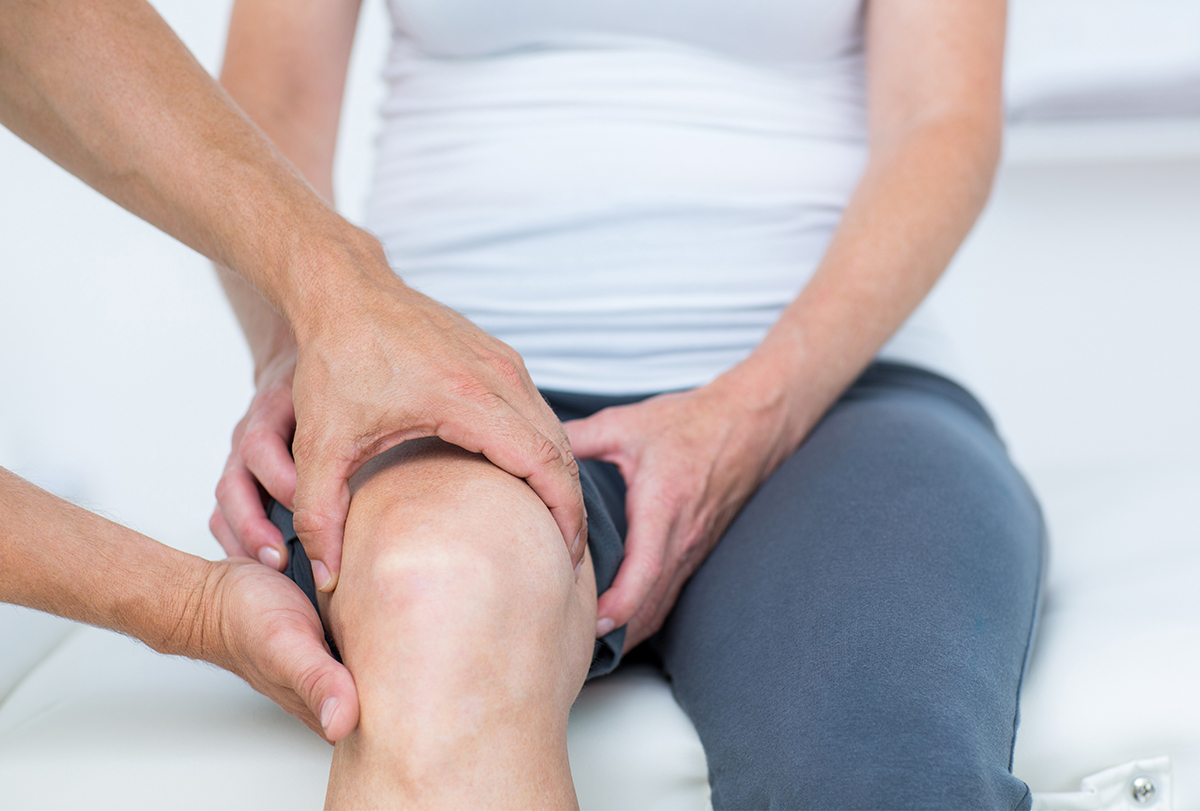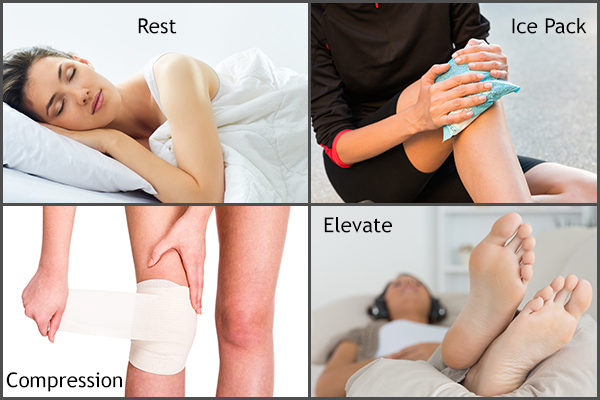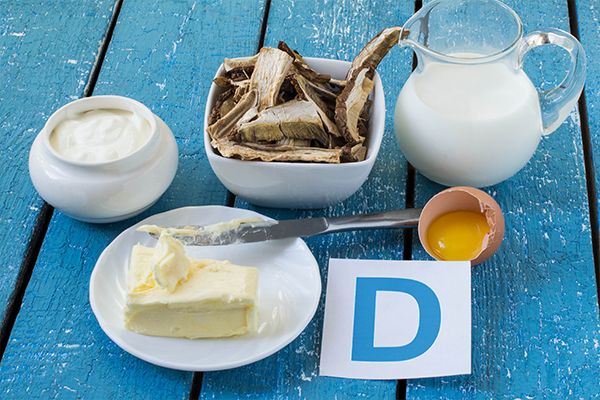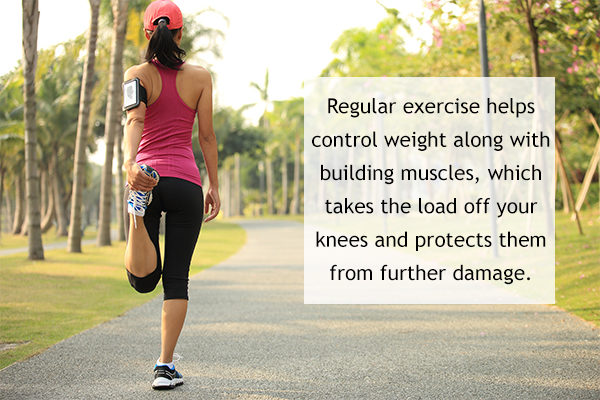In this article:
Knee problems are a common occurrence, and the extreme pain can hinder your daily activities, such as walking.

Most knee problems are a result of continual stress and old age, but injuries or sudden straining movements can also cause knee pain. The pain can range from a mild nuisance to a disabling impediment, and its intensity may increase over time.
This article lists simple things you can do at home to manage and prevent knee pain and inflammation.
Home Remedies to Reduce Knee Pain
The following home remedies can aid in knee pain alleviation.
1. RICE treatment for immediate relief

RICE, which stands for rest, ice, compression, and elevation, can help subdue knee inflammation when performed twice or thrice daily.
- Rest: Give rest to your knees from the activities that can irritate it and aggravate the inflammation.
- Ice: Apply ice to your knees for 15 minutes to subside the inflammation. The cold, restricts blood flow to the knee and acts as an anesthetic to help relieve the pain. Place a towel on your knee before applying the ice and avoid long exposure as it can lead to frostbite.
- Compression: Use a tight wrap or bandage around the knee to restrict blood flow and heat in the area.
- Elevate: Elevate the knee above the heart level to help increase blood flow back to the heart. This helps in removing excessive blood from your knee and boosts circulation.
Performing RICE (rest, ice, compression, and elevation) two to three times a day is generally the first line of treatment for most knee pains.
2. Use ginger
Consuming powdered ginger regularly can help relieve pain in a way similar to ibuprofen without any risk of intestinal damage.
A study conducted in 2013 demonstrated that ginger powder aids relief from symptoms of osteoarthritis and is safe to use. (1) Additionally, using ginger oil to massage the knee is an effective adjunct therapy. (2)
How to use:
Consume ¼ to ½ teaspoon of ginger orally upon consulting your doctor or use ginger oil for topical massage.
Ginger possesses anti-inflammatory properties which can help relieve knee pain when used orally or topically.
3. Try krill oil
Krill oil is known to have anti-inflammatory effects that can help reduce knee pain.
A random clinical trial in 2016 demonstrated that administering krill oil at a dosage of 2 g/day for 30 days helped alleviate the symptoms associated with mild knee pain in adults. (3)
Additionally, the consumption of krill oil and supplemented diet helps reduce arthritis. (4) However, oral intake should be first discussed with a doctor.
The oral and topical use of krill oil can help alleviate knee pain by reducing inflammation.
4. Use eucalyptus oil
Eucalyptus oil is known to have a minty scent that aids pain relief, especially beneficial for patients of osteoarthritis and knee pain.
A study conducted in 2013 demonstrated that eucalyptus oil inhalation helped in reducing knee pain in patients who went through total knee replacement surgery. (5)
A study in 2016 concluded that extracts of eucalyptus contain anti-inflammatory properties, and a reduction in the levels of TNF-α and IL6 was seen upon usage. (6)
How to use:
Eucalyptus oil can be consumed orally in the form of supplements, applied topically for massage, or even used for aroma therapy.
The use of eucalyptus oil as a supplement or in aromatherapy is shown to be beneficial for knee pain.
5. Consume vitamin D

Low vitamin D levels are associated with dysfunction and pain in people with knee pain. A poor knee function during balance recovery, aggravated pain, and locomotor dysfunction were seen in osteoarthritis patients with vitamin D deficiency. (7)
A study conducted in 2015 concluded that treating vitamin D deficiency in patients with arthritis helped improve their quadriceps muscle strength and lower knee pain. (8) However, another study showed that vitamin D supplementation did not help improve knee pain in patients with symptomatic osteoarthritis. (9)
How to use:
It is best to increase your vitamin D uptake by consuming vitamin D rich foods such as milk. You can also use supplements upon consulting your doctor.
While some studies support the use of vitamin D for improving knee pain, further research is required to establish its efficacy.
6. Try a castor oil pack
Castor oil has been long used for treating various pains, including sciatica and arthritis. It has been found to possess anti-inflammatory ricinoleic acid which may help reduce pain. (10) However, its use is based on anecdotal evidence and therefore should only be used as an additional therapy with caution.
How to use:
- Prepare calendula tea by steeping the herb in around three cups of boiling water and strain.
- Soak a cloth in the warm tea.
- Massage the affected knee with castor oil and cover with the soaked cloth, leaving it for up to 7 hours.
7. Massage with olive oil
Olive oil contains various active compounds that aid in reducing joint damage from rheumatoid arthritis. (11)
How to use:
Take a little amount of olive oil and use it to massage your knee with gentle movements.
Note: Various other oils, including mustard, coconut, sesame, and cinnamon oil are used for knee massage. However, it is important to discuss it with your doctor as there is no research to support their use.
8. Apply turmeric
Turmeric is a popular anecdotal remedy that is supposed to help reduce inflammation, and thus relieve the pain associated with arthritis. (12)
How to use:
Make a turmeric paste by mixing turmeric powder with oil or water and apply on the affected area.
9. Use apple cider vinegar
ACV may help reduce inflammation and alkalize the body, contributing to pain management. However, the use of ACV for knee pain is purely anecdotal, and therefore should be employed with caution.
How to use:
Dilute ACV in water and consume as a tonic. Alternatively, soak a cloth with diluted ACV and wrap over the affected area. Further, cover the cloth using a plastic wrap and bandage, and leave for 6–8 hours.
10. Try willow bark extract
Willow bark extract has been used as an analgesic, antipyretic, and anti-inflammatory agent for long. However, there are very limited scientific studies available to support these claims. (13)
The limited evidence suggests that willow bark contains salicin which can help lower the production of pain-inducing chemicals in osteoarthritis patients. However, since there is a lack of proper scientific research, it is best to consult your doctor before using willow bark extracts.
Alternative Therapies
There are a few alternative therapies that can help manage pain. However, it is essential to seek the help of an expert for undergoing these therapies.
1. Tai chi
This traditional Chinese practice involves gentle movement, meditation, deep breathing, and awareness exercises.
A study demonstrated that patients who underwent Tai chi training had more control over their pain and physical functioning when compared to the patients who chose a stretching program and wellness education. (14)
2. Acupuncture
In one study, laser and needle acupuncture therapy given for 12 weeks reduced knee pain as opposed to no treatment. However, the effect was non-significant when compared to sham laser acupuncture. More direct studies are needed to determine the efficiency of acupuncture in pain alleviation. (15)
Lifestyle Changes to Prevent Knee Pain
The following self-care tips can help manage and prevent knee pain.
1. Exercise regularly

It is essential to stay active and perform daily exercises. However, care should be taken not to overdo it. Strength training that is focused on building up the hamstrings and quadriceps can help manage arthritis and other knee problems.
Additionally, regular exercises help control weight along with building muscles, therefore protecting the knees from further damage. A physiotherapist can develop an appropriate regimen for you and provide guidance.
It is vital to warm up and to limber down as well. Stretch the front and back muscles of your thigh to prevent problems. (16)(17)
2. Stand up straight
Maintaining your posture is important to prevent knee problems. Stand up straight with your head, shoulders, hips, knees, and feet in correct alignment with each other.
Moreover, practicing yoga, Pilates, or performing exercises such as back extensions and planks that help strengthen your core can help improve your posture. These activities also help in preventing irritation around or under the kneecaps and aid balance.
3. Maintain a healthy weight
Lose weight if you are obese or overweight. This is important as every pound of excess weight puts a pressure equal to 5 pounds on your knees while climbing stairs. You may consult your doctor for tips on losing weight since shedding the extra pounds will relieve pressure from your knees.
4. Wear proper shoes
Select a pair of well-fitting shoes to prevent foot injuries and related knee pain. Avoid stiff and narrow shoes that crowd your toes or high-heeled shoes that put pressure on the balls of your feet. (18)
You may try shoe inserts, arch supports (orthotics), or special shoes if you have flat feet. Choose shoes that are suitable for the athletic activity you perform, keeping in mind your unique foot structure and biomechanics.
5. Follow a healthy diet
Chia seeds, walnuts, and foods loaded with omega-3 fatty acids are known to help subside inflammation. (19) Also, the consumption of vegetables and fruits can provide your body with pain-reducing antioxidants.
Eating a diet enriched with such foods also helps you lose weight, consequently reducing the pressure on your knee joints.
6. Avoid smoking
Smoking can hinder the body’s healing processes and impedes blood flow. This results in delayed improvement of injuries and inflammation.
7. Massage regularly
Massages are popular for stress relief, but they can also help alleviate joint pain. Massaging can also help break the pain cycle, reduce edema, improve functioning, aid treatment of various medical conditions, and promote relaxation. (20)
Aromatherapy massage was found to reduce morning stiffness, lower knee pain, and improve physical functioning in patients with osteoarthritis. (21)
8. Manage your stress
Chronic stress can lead to inflammation. (22) Exercises or other relaxation techniques can help manage your stress and pain. (23)
9. Pay attention to pain
Do not ignore any mild pain until it becomes severe. Rather, consult your doctor at the earliest for proper diagnosis and treatment.
Final Word
The knee enables you to stand, walk, and run. The weight of the entire body falls on this joint, which invariably leads to a lot of structural wear and tear over the years. Fortunately, most cases of knee pain can be treated with ice application, rest, medications, stretching, and strengthening exercises.
However, if the symptoms persist despite the necessary care and treatment, consult your doctor to upgrade your treatment and identify any serious underlying damage.

- Was this article helpful?
- YES, THANKS!NOT REALLY


